
Sandesh (the magazine) & its delightful covers have been a part of my childhood. The covers and the fine illustrations have also in various ways shaped my graphic sensibilities. Some of the iconic designs for Sandesh by Satyajit Ray will remain the finest examples of graphic art produced in Bengal. So when I had the opportunity to design a cover for the magazine’s latest edition, I knew it was going to be a homage to the ideas and impressions that I generally associate with the magazine.

Sandesh, 2011 by Shubho Roy, Rarh Design Studio
I had in mind the simple 3-color (sometimes 4-color) designs by Ray. Sandesh covers, for me, have always been about a very simple brand of humor & that famous Sandesh smile – that toothy grin of surprise & innocence. Also, the pair of mascots (the boy and the girl), and that pot of sandesh (the sweet, which returns from time to time as a visual clue) had to be there. There was always going to be a reference to printing, as Upendrakishore’s pioneering printing house U Ray & Sons (where the first Sandesh was printed) comes to mind, along with Satyajit’s science fiction fantasies with a youthful intermingling of diverse scientific technologies. I also remember the illustrations of W Heath Robinson, the British cartoonist, whose elaborate drawings of fantastic contraptions were always a special attraction of Sandesh. I knew I had to bring all these elements together to sum up what Sandesh meant to me. Since Sandesh never had a fixed logo, or a masthead, designing a cover art meant an integrated lettering – each Sandesh cover has a unique masthead.
What I have published above is the artwork I had left at 1/1 Bishop Lefroy Road a couple of months ago. I understand some additions & modifications are inevitable when the in-house design team attempts to fit the artwork in their current scheme.
Here, I leave you with a few of my favorite Sandesh covers by Satyajit Ray. Some of these covers have been printed in rotation, and as a result many issues bear the same cover art, with minor changes in color.
![]()
The Peacock Ship:
The peacock-ship is a recurring motif in Bengali fairy tales, where kings and merchants traveled to distant seas in the search of fortunes. I love the stylized lettering in the shape of a sail, maybe a visual pun with the word ‘masthead’, and the overall design is masterly. The crow probably suggests that land is near.
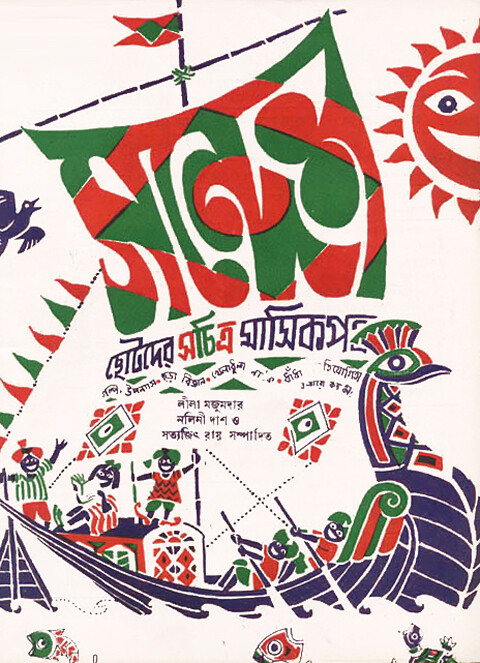
Sandesh, cover art, by Satyajit Ray
![]()
The Strongman:
I love the simple humor of this piece, the composition, the expression of the pahalwan, and his hairdo, which echoes his mustache.
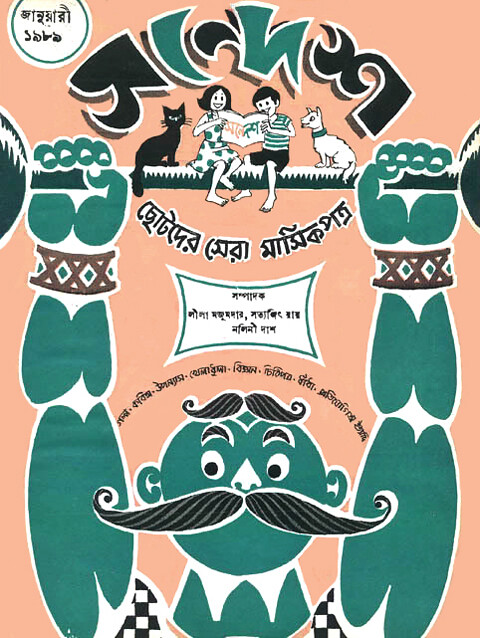
Sandesh, cover art, by Satyajit Ray
![]()
The Space-Robot:
My favorite, the happy space-robot and its happy pair of eyes. Everything about this design works – the colors, the shapes, and the electric radiation of happiness in the form of a jagged contour. But best of all, the tiny Sandesh in the large pair of mechanical hands creates a strange sense of a very endearing disparity.

Sandesh, cover art, by Satyajit Ray
![]()
The King:
The absent-minded ruler who neglected his administrative duties for the sake of simple pleasures was a recurring motif in Satyajit’s oeuvre:
From the childlike king in Goopy Gyne Bagha Byne, to the literary-minded ruler of Lucknow in Satranj Ke Khiladi, to this one here who indulges in both kinds of Sandesh, the sweet & the magazine, oblivious to the affairs of the state.
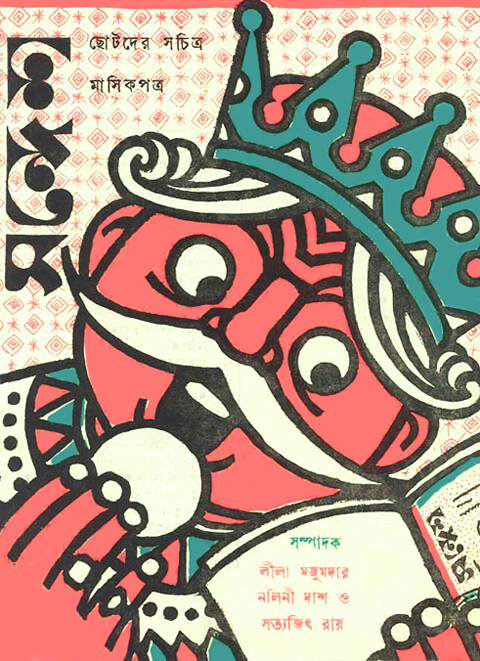
Sandesh, cover art, by Satyajit Ray
![]()
The Ringmaster:
I love the figure of the ringmaster here & how he is graphically constructed with simple shapes.
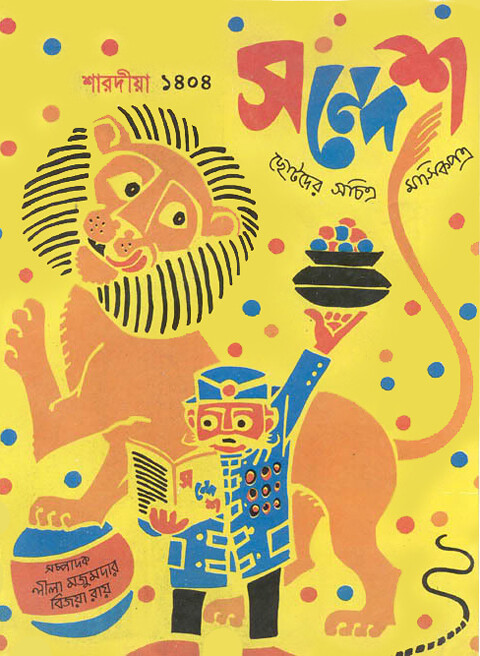
Sandesh, cover art, by Satyajit Ray
![]()
The Clown:
The one below, visibly different from the rest of the designs, is the first Sandesh cover designed by Ray, when he revived the magazine in 1961.
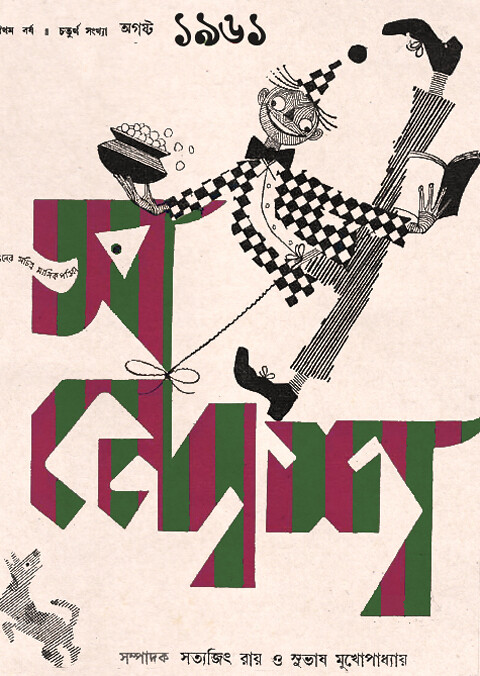
Sandesh, cover art, by Satyajit Ray
![]()
Hanuman:
Another early design, first appearing in 1961. The classic Sandesh-style is in formation here. The theme is clear, it fuses two Hanuman stories into one: the image plays on the myth of the monkey-warrior carrying the mountain, but here, it’s a mountain of sandesh (the sweet); but Hanuman is also the ‘original’ messenger of Indian mythologies, who carried Rama’s message (sandesha, in Sanskrit) across the sea.
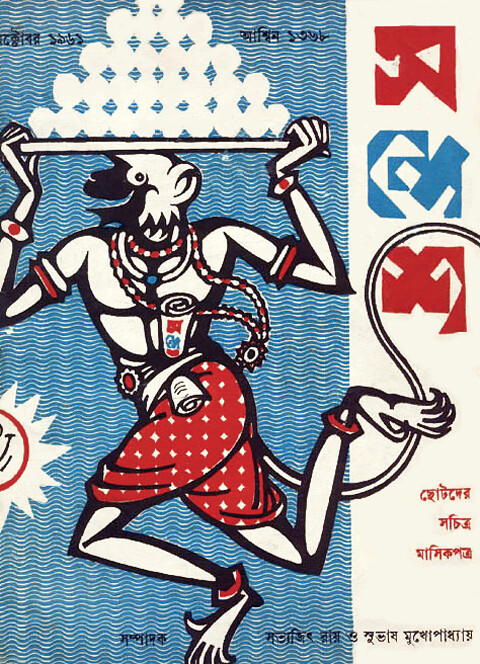
![]()
The magazine was first started in 1913 by Upendrakishore Ray, who called it Sandesh to imply the nature of the magazine, which was informative and entertaining, as Sandesh in Bengali is both news and a type of sweet. Upendrakishore edited it till his death in 1915, when his illustrious son Sukumar took over. Upon Sukumar’s death in 1923, his brother Subinoy continued the publication till 1934, when the magazine closed down. Satyajit revived it after a gap of 27 years. This year is the 50th anniversary of the revival.
![]()
© Rarh Design Studio, 2011
Anamika / 03 Oct 2011